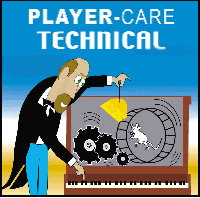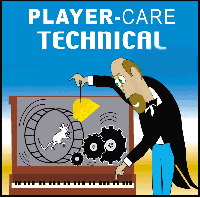
|

|

|

|

|

|
| Home | Manuals | Supplies | Search | Consult | Contact | Testing | Service |


The Lower Section: |
|
What is the Lower Section? Where is it located? What does it do? Before we can begin, we have to get a few terminologies straight. The bellows that are connected to the foot treadles (or pedals) are called the Exhausters. That's because they 'exhaust' (or pull out) the air from the player mechanism. Connected directly to the Exhausters (via a trunk or channel) are the Reservoirs. Some units have a single reservoir and I have seen units with two reservoirs AND an Equalizer bellows which is attached to one or both of the Reservoirs. Check out the rough drawings by Clicking Here Testing the Lower Section is actually pretty easy by comparison to some of the other components in a player piano. In a nut shell, remove all the hoses connected to the lower section, tape all the exposed nipples (or flanges) closed with a good duct tape and start pumping. In an excellent lower section, the vacuum will build up so rapidly that after two or three pumps, the reservoirs will be completely collapsed and further pumping will be extremely difficult. Forcing the unit further could cause damage. On the other end of the spectrum, if you pump and pump and the unit never seems to 'lock-up', then you've got some serious leakage. Most leakage can be traced to the bellows cloth and/or the flap valves on the back of the exhausters. If the Reservoirs collapse most of the way and it takes more than just a few seconds to reopen, then count how long it takes. If it takes more than 12 seconds to go from fully collapsed to fully open, then the unit is in fair condition. Rebuilt units will hold vacuum for over a minute in some cases. Most manufactures required a minimum of 30 seconds before the lower section was installed. If the reservoir bellows never fully collapses or only collapses part way and opens back up as soon as you stop pumping, you have serious leakage. Sometimes, cracks develope in the wooden parts and the wood (plywood) literally 'comes apart'. This is not always obvious to the naked eye unless you hit the wood with the fleshy side of your fist. Then you will hear a 'slapping' type sound. Cracks also develope at the seams where various pieces are glued together. This actually happens quite a bit in 1920's units. It's due to their age. All wood continues to dry and shrink for many, many years. At some point, if not well sealed, the seams split open and let the air 'in'. Since the unit stores vacuum, sealing these types of cracks with Phenoseal or other such sealers is a reasonable 'quick fix'. However, it is better to remove, clean, reglue and clamp this type of damage. Test the Air-Motor Test The Stack Re-Tubing the Tracker Bar The Tracking Device Stack Leakage Test |

![]() ..To
The Top of this Page . . . . . . . . . . .
..To
The Top of this Page . . . . . . . . . . . ![]() ..To The HOME Page
..To The HOME Page
|
Since "Player-Care" is an internet business, I prefer that we correspond via E-Mail (click here to fill out the 'Request Form'). However, if I'm not in the middle of some other activity, you can reach me at 732-840-8787. But please understand that during the hours from 8AM-5PM EST (Mon-Sat), I'm generally quite busy. So, I probably won't answer the phone. If you get the answering machine, please leave a detailed message stating the reason for your call. Also, repeat your name and phone number clearly and distinctly. By necessity, I prioritize everything in my life. And, if you call and just leave your name and number, and ask me to call you back, it might be a day or two before I return your call. Why? Because I don't know why you want me to call and I might not be prepared to assist you in an effective and efficient manner. If you leave me an E-Mail address (which I prefer), spell it out phonetically. The more you do to help me, the more I can help you in return. Don't rush. You have four minutes to record your message. |
|
407 19th Ave, Brick, NJ, 08724 Phone Number 732-840-8787 (Voicemail Only, No Texts) |
